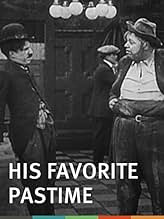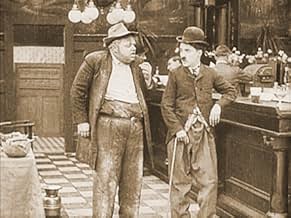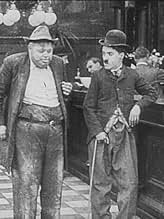PUNTUACIÓN EN IMDb
4,9/10
1,3 mil
TU PUNTUACIÓN
Añade un argumento en tu idiomaA very plastered fella follows a pretty woman home, and proceeds to make a nuisance of himself.A very plastered fella follows a pretty woman home, and proceeds to make a nuisance of himself.A very plastered fella follows a pretty woman home, and proceeds to make a nuisance of himself.
- Dirección
- Guión
- Reparto principal
Peggy Pearce
- Wife
- (as Velma Pearce)
Helen Carruthers
- Servant
- (sin acreditar)
Jess Dandy
- Minor Role
- (sin acreditar)
Hampton Del Ruth
- Drinker with Moustache
- (sin acreditar)
Billy Gilbert
- Shoeshine Boy
- (sin acreditar)
William Hauber
- Shoeshine Customer
- (sin acreditar)
- …
George Jeske
- Servant
- (sin acreditar)
Edgar Kennedy
- Tough Guy in Bar
- (sin acreditar)
Harry McCoy
- Bar Patron
- (sin acreditar)
Rube Miller
- Bar Patron
- (sin acreditar)
Reseñas destacadas
Am a big fan of Charlie Chaplin, have been for over a decade now. Many films and shorts of his are very good to masterpiece, and like many others consider him a comedy genius and one of film's most important and influential directors.
Everybody has to have at least one misfire in their careers, even the best directors and actors have not so good films or films they regret. From his early still evolving period before he properly found his stride and fairly fresh from his vaudeville background, 'His Favourite Pastime' shows that Chaplin is not immune from this. While an important milestone period for him, his Keystone years/films were watchable and interesting enough overall but patchy, none being among his best work.
'His Favourite Pastime' has a few good points. While a little primitive and not exactly audacious, the production values are far from cheap. Fatty Arbuckle does bring some zest to his role.
There are also a few amusing moments, the highlight being Chaplin's saloon toilet door fight which is actually very funny and in a different league to the rest of the material.
Where 'His Favourite Pastime' falls down is that mostly it's not particularly funny. The timing feels limp and there is very little, if any, freshness or originality apart from that aforementioned scene with the saloon toilet door. There is not much charm here and there is not much to be emotionally invested by. The story is flimsy, so much so things feel over-stretched, there are not many Chaplin short films where a short length feels very dull but 'His Favourite Pastime' is one of them.
Found myself uncharacteristically disappointed by Chaplin, which was not expected because generally even in lesser efforts he was one of the better things about them. Here he does not look interested and goes through the motions, there is none of the comedy/directing genius that he is deservedly hailed for. Arbuckle aside, the rest of the cast are not much to write home about.
In conclusion, an early career misfire. 4/10 Bethany Cox
Everybody has to have at least one misfire in their careers, even the best directors and actors have not so good films or films they regret. From his early still evolving period before he properly found his stride and fairly fresh from his vaudeville background, 'His Favourite Pastime' shows that Chaplin is not immune from this. While an important milestone period for him, his Keystone years/films were watchable and interesting enough overall but patchy, none being among his best work.
'His Favourite Pastime' has a few good points. While a little primitive and not exactly audacious, the production values are far from cheap. Fatty Arbuckle does bring some zest to his role.
There are also a few amusing moments, the highlight being Chaplin's saloon toilet door fight which is actually very funny and in a different league to the rest of the material.
Where 'His Favourite Pastime' falls down is that mostly it's not particularly funny. The timing feels limp and there is very little, if any, freshness or originality apart from that aforementioned scene with the saloon toilet door. There is not much charm here and there is not much to be emotionally invested by. The story is flimsy, so much so things feel over-stretched, there are not many Chaplin short films where a short length feels very dull but 'His Favourite Pastime' is one of them.
Found myself uncharacteristically disappointed by Chaplin, which was not expected because generally even in lesser efforts he was one of the better things about them. Here he does not look interested and goes through the motions, there is none of the comedy/directing genius that he is deservedly hailed for. Arbuckle aside, the rest of the cast are not much to write home about.
In conclusion, an early career misfire. 4/10 Bethany Cox
In 1914, Charlie Chaplin began making pictures. These were made for Mack Sennett (also known as "Keystone Studios") and were literally churned out in very rapid succession. The short comedies had very little structure and were completely ad libbed. As a result, the films, though popular in their day, were just awful by today's standards. Many of them bear a strong similarity to home movies featuring obnoxious relatives mugging for the camera. Many others show the characters wander in front of the camera and do pretty much nothing. And, regardless of the outcome, Keystone sent them straight to theaters. My assumption is that all movies at this time must have been pretty bad, as the Keystone films with Chaplin were very successful.
The Charlie Chaplin we know and love today only began to evolve later in Chaplin's career with Keystone. By 1915, he signed a new lucrative contract with Essenay Studios and the films improved dramatically with Chaplin as director. However, at times these films were still very rough and not especially memorable. No, Chaplin as the cute Little Tramp was still evolving. In 1916, when he switched to Mutual Studios, his films once again improved and he became the more recognizable nice guy--in many of the previous films he was just a jerk (either getting drunk a lot, beating up women, provoking fights with innocent people, etc.). The final evolution of his Little Tramp to classic status occurred in the 1920s as a result of his full-length films.
This short featured Chaplin and Fatty Arbuckle. Both were major early comedy stars. Unfortunately, neither comedian looked terribly funny or interesting in this short about jealousy. Too bad, as I had hoped for so much more from these stars.
The Charlie Chaplin we know and love today only began to evolve later in Chaplin's career with Keystone. By 1915, he signed a new lucrative contract with Essenay Studios and the films improved dramatically with Chaplin as director. However, at times these films were still very rough and not especially memorable. No, Chaplin as the cute Little Tramp was still evolving. In 1916, when he switched to Mutual Studios, his films once again improved and he became the more recognizable nice guy--in many of the previous films he was just a jerk (either getting drunk a lot, beating up women, provoking fights with innocent people, etc.). The final evolution of his Little Tramp to classic status occurred in the 1920s as a result of his full-length films.
This short featured Chaplin and Fatty Arbuckle. Both were major early comedy stars. Unfortunately, neither comedian looked terribly funny or interesting in this short about jealousy. Too bad, as I had hoped for so much more from these stars.
His Favorite Pastime is only about 16 minutes long, yet I found it so boring I nearly fell asleep. The plot makes even less sense than usual, and Chaplin seems to be sleepwalking through the comedy.
There are a few interesting gags, such as The Tramp vs. a pair of saloon doors, and later, the Tramp riding the front of a streetcar, but nothing really gels in this early silent Chaplin. His drunk act was starting to get old by this point, and in fact the character he plays here is little different than the character he played in his previous film, Tango Tangles, except that the comedy in the earlier short is far superior.
My advice: unless you have a desire to see every film Chaplin made, good or bad, skip this one.
There are a few interesting gags, such as The Tramp vs. a pair of saloon doors, and later, the Tramp riding the front of a streetcar, but nothing really gels in this early silent Chaplin. His drunk act was starting to get old by this point, and in fact the character he plays here is little different than the character he played in his previous film, Tango Tangles, except that the comedy in the earlier short is far superior.
My advice: unless you have a desire to see every film Chaplin made, good or bad, skip this one.
7tavm
This Charlie Chaplin short was the first I watched on the 2 DVD collection of his courtesy of the Platinum Disc Corporation. In this one, he's the familiar Tramp character who's drunk the whole time so anything he does here is the result of his inebriation. As a result, I actually found most of it funny especially early on when one of the people he encounters is fellow comic Roscoe "Fatty" Arbuckle as a fellow bar patron who tries to get his drink without Chaplin looking. Since Arbuckle wasn't yet a star, that's all we see of him though he makes a good impression here. Most of the time, it's just Charlie as he stumbles through missing punches or getting punched, going into someone's house and getting the residents' reactions, or scaring some dark-skinned servants (obviously caricatured by Caucasian humans though not as offensively portrayed since there's no white lips or other stereotypical characteristics). Quite funny for an early effort so on that note, I recommend His Favorite Pastime.
In another disappointing short comedy, Charlie Chaplin once again plays the standard, belligerent drunk, drinking himself into oblivion and then stumbling around this run-of-the-mill slapstick comedy. There are some mildly interesting items, such as the fact that the altogether unamusing but watchable opening scene features Chaplin and Keystone colleague Fatty Arbuckle as fellow drinkers in the pub, taking beers away from each other and gradually getting drunker and drunker, as well as the fact that this is one of the earliest, maybe even the origin, of one of Chaplin's gags that he would later perfect and use with great success, the lighting of the match on the seat of his pants. Other than that, there is not much else of note here.
The comedy of the film is really nonexistent, which is not to say that it is entirely bad, just a failed experiment. The obnoxious drunk has long since lost its appeal, if it ever had any, and I imagine even audiences back in 1914 must have been getting tired of it. The film features some of the most blatant racism of any of his films, although certainly not the last (remember the three minds with but a single thought from A Day's Pleasure?). At one point late in the film, Charlie follows a woman right into her home and hits on her, and is then horrified when he realizes that she is black. He also drops a lighted match into a black man's hand when he holds it out for a tip, which is exactly the kind of thing that makes this drunken character so dislikable.
Most of the rest of the film is composed of people pushing and shoving other people around and hitting each other, and ultimately it seems that Chaplin simply uses drunkenness in the film to serve as a reason to stagger around and hit people and get in fights with swinging doors and fall over stairway banisters and such. The plot outline on the IMDb says "A very plastered fella follows a pretty woman home, and proceeds to make a nuisance of himself." And sadly, there's not much difference between watching the film and reading that one line.
The comedy of the film is really nonexistent, which is not to say that it is entirely bad, just a failed experiment. The obnoxious drunk has long since lost its appeal, if it ever had any, and I imagine even audiences back in 1914 must have been getting tired of it. The film features some of the most blatant racism of any of his films, although certainly not the last (remember the three minds with but a single thought from A Day's Pleasure?). At one point late in the film, Charlie follows a woman right into her home and hits on her, and is then horrified when he realizes that she is black. He also drops a lighted match into a black man's hand when he holds it out for a tip, which is exactly the kind of thing that makes this drunken character so dislikable.
Most of the rest of the film is composed of people pushing and shoving other people around and hitting each other, and ultimately it seems that Chaplin simply uses drunkenness in the film to serve as a reason to stagger around and hit people and get in fights with swinging doors and fall over stairway banisters and such. The plot outline on the IMDb says "A very plastered fella follows a pretty woman home, and proceeds to make a nuisance of himself." And sadly, there's not much difference between watching the film and reading that one line.
¿Sabías que...?
- CuriosidadesThis film is among the 34 short films included in the "Chaplin at Keystone" DVD collection.
Selecciones populares
Inicia sesión para calificar y añadir a tu lista para recibir recomendaciones personalizadas
Detalles
- Fecha de lanzamiento
- País de origen
- Sitios oficiales
- Idiomas
- Títulos en diferentes países
- Su pasatiempo favorito
- Empresa productora
- Ver más compañías en los créditos en IMDbPro
- Duración16 minutos
- Color
- Mezcla de sonido
- Relación de aspecto
- 1.33 : 1
Contribuir a esta página
Sugerir un cambio o añadir el contenido que falta


























